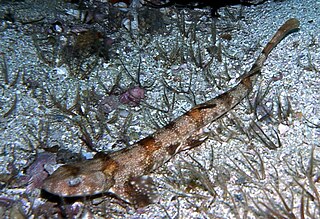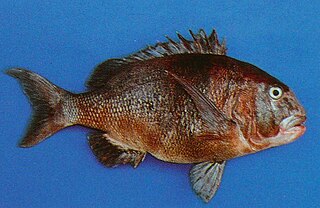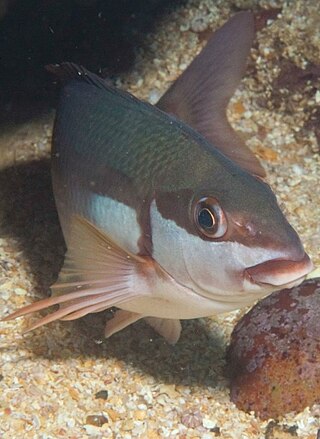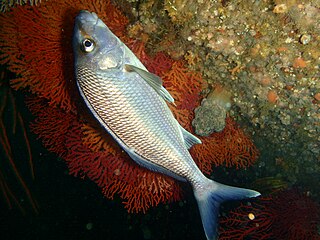
The red forest duiker, Natal duiker, or Natal red duiker is a small antelope found in central to southern Africa. It is one of 22 extant species form the subfamily Cephalophinae. While the red forest duiker is very similar to the common duiker, it is smaller in size and has a distinguishing reddish coloring. Additionally, the red forest duiker favors a denser bush habitat than the common duiker. The Natal red duiker is more diurnal and less secretive than most forest duikers, so therefore it is easier for them to be observed. In 1999, red forest duikers had an estimated wild population of 42,000 individuals.

The gummy shark, also known as the Australian smooth hound, flake, sweet william or smooth dog-shark, is a shark in the family Triakidae. These small to medium-sized bottom-dwelling sharks are found mostly in, but are not limited to, the area around the southern seas of Australia and is commonly baited and fished for cuisine because of its taste and market prices. According to a 2021 paper by White, Arunrugstichai & Naylorn (2021), Mustelus walkeri is the same animal as M. antarcticus. One theory is that M. walkeri is a subpopulation of M. antarcticus.

The barred fingerfin is a species of marine ray-finned fish, belonging to the family Cheilodactylidae, commonly referred to as morwongs. It is found only in the southeastern Atlantic and southwestern Indian Oceans off the coasts of South Africa.

The blackspot shark is a small species of requiem shark in the family Carcharhinidae found in the tropical Indo-West Pacific Ocean between latitudes 24°N and 30°S, from the surface to a depth around 40 m (130 ft). Its length is a little under one meter (yard) and it is not considered to be dangerous to humans. It feeds mainly on fish, crustaceans, and squid. This shark is also caught in small-scale fisheries for human consumption.

The white-spotted Izak or African spotted catshark is a catshark of the family Scyliorhinidae. It is found in the western Indian Ocean off the coasts of Natal, South Africa, southern Mozambique, Madagascar, Kenya, and Tanzania between latitudes 4° S and 37° S, at depths of between 220 and 440 m. It can grow up to 35 cm in length.

The puffadder shyshark, also known as the Happy Eddie, is a species of catshark, belonging to the family Scyliorhinidae, endemic to the temperate waters off the coast of South Africa. This common shark is found on or near the bottom in sandy or rocky habitats, from the intertidal zone to a depth of 130 m (430 ft). Typically reaching 60 cm (24 in) in length, the puffadder shyshark has a slender, flattened body and head. It is strikingly patterned with a series of dark-edged, bright orange "saddles" and numerous small white spots over its back. The Natal shyshark, formally described in 2006, was once considered to be an alternate form of the puffadder shyshark.

The yellowspotted catshark is a rare catshark of the family Scyliorhinidae. It is found in the southeast Atlantic, from Lüderitz, Namibia to central Natal, South Africa, between latitudes 0° and 37° S. It can grow up to a length of about 1.22 metres. The reproduction of this catshark is oviparous.

The comber is a species of marine ray-finned fish from the family Serranidae, the sea basses. It is widely distributed in the eastern North and South Atlantic Oceans and into the southwestern Indian Ocean. It is caught for food and fishmeal in some parts of its range.

Epinephelus andersoni, the catface grouper, brown-spotted grouper, catface rockcod or brown spotted rockcod, is a species of marine ray-finned fish, a grouper from the subfamily Epinephelinae which is part of the family Serranidae, which also includes the anthias and sea basses. It is found in the southwestern Indian Ocean where it is associated with reefs.

The black musselcracker is a South African species of marine fish in the family Sparidae. It is the only species of its genus Cymatoceps. It reaches 1.5 m in length and almost 35 kg (77 lb) in weight. It is found in coastal rocky areas to depths of 80 m (260 ft), and feeds on hard-shelled invertebrates such as crabs and sea urchins.
Gilchristella aestuaria, the Gilchrist's round herring or estuarine round-herring, is a member of the herring family Clupeidae that occurs off the coasts of Southern Africa. It is the only species in its genus, which was named for John Dow Fisher Gilchrist (1866–1926).

Chirodactylus is a genus of marine ray-finned fish, traditionally regarded as belonging to the family Cheilodactylidae, the members of which are commonly known as morwongs. They are native to the Atlantic, Indian and eastern Pacific oceans off southern Africa and South America.

Selene orstedii, the Mexican moonfish, is a species of ray-finned fish within the family Carangidae. The species is found in the eastern Pacific Ocean, off the coasts of Baja California, Mexico to Ecuador. It grows to a max length of 33 centimeters, but is more commonly found at 25 centimeters in length. Adults are found in shallow coastal waters at depths up to 50 meters below sea level, usually near the seafloor. Its diet consist of squid, small crabs, small fishes and polychaetes.
Umbrina reedi is a species of ray-finned fish within the family Sciaenidae. It is endemic to the southeastern Pacific Ocean, where it is found off the Juan Fernandez Archipelago and Isla San Felix in the Desventuradas Islands, inhabiting rocky shores at depths up to 30 meters. The maximum length of the species has been recorded at 77 centimeters.

Harpagifer bispinis, the Magellan plunderfish, is a species of ray-finned fish within the family Harpagiferidae. The species is found in the south Pacific and south Atlantic around the Straits of Megellan, south of Chile and Argentina. Other areas it is found near around this range include Patagonia, the Falkland Islands, Isla de los Estas, and some subantarctic islands.
Scomberesox simulans, the dwarf saury, is a species of ray-finned fish within the family Scomberesocidae, found in the Atlantic and Indian Ocean. It inhabits tropical and subtropical waters near the surface as a pelagic-oceanic species, migrating as the ocean warms in the spring and summer. It mainly feeds on planktonic organisms. The maximum length recorded was 13 centimeters in length, although the species is most commonly found at 9-10 centimeters in length. It is often confused as the juvenile form of the Atlantic saury.
Zu elongatus, the taper-tail ribbonfish, is a species of ray-finned fish within the family Trachipteridae. The species distribution is likely in temperate and tropical waters in all oceans, but has only been occurred in the Atlantic and Pacific off Namibia, the western Cape coast, and New Zealand. It inhabits mesopelagic waters up to 1200 meters below sea level. Other common names include the scalloped dealfish and spitsstert-lintvis in Afrikaans.

Palinurus gilchristi, the southern spiny lobster, is a species of spiny lobster within the family Palinuridae.

Chirodactylus brachydactylus, the twotone fingerfin, is a species of marine fish in the fingerfin (morwongs) family of order Perciformes. It is native to the coast of southern Africa.

Chirodactylus grandis, the Bank steenbras, is a species of marine fish in the fingerfin or morwong family of order Perciformes. It is native to the coasts of South Africa. and Namibia
















